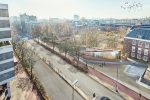A bird’s-eye view of the Holocaust Memorial of Names to be built in Amsterdam. (photo from holocaustnamenmonument.nl)
More than 70 years after the Second World War, a memorial in Amsterdam will be erected with the names of all the Dutch Holocaust victims. This will finally provide the Netherlands with a tangible memorial where the 102,000 Jewish victims and 220 Sinti and Roma victims can be commemorated individually and collectively.
Up to now, no memorial in the Netherlands has listed each individual Holocaust victim by name. For surviving relatives, a place to commemorate family members is invaluable. In addition, a memorial listing the more than 102,000 names serves as a reminder to current and future generations of the dangers of racism and discrimination.
Between 1933 and 1945, the Nazis murdered an estimated six million Jews and hundreds of thousands of Sinti and Roma. Of the 140,000 Jews who lived in the Netherlands in 1940, 102,000 did not survive the war.
Not all Jews were murdered in the gas chambers of the extermination camps Auschwitz-Birkenau, Treblinka, Belzec, Majdanek, Chelmno and Sobibor. Many were murdered in mass executions or died as a result of sickness, hunger, exhaustion or slave labour. The Dutch Holocaust Memorial of Names commemorates all these victims.
Designed by Polish-Jewish architect Daniel Libeskind, whose studio is headquartered in New York City, the Dutch Holocaust Memorial of Names will be located in the heart of the Jewish Quarter of Amsterdam. The memorial consists of the four Hebrew letters that make up the word zachor, to remember. When visitors enter the memorial, they find themselves in a labyrinth of passageways flanked by two-metre-tall brick walls that convey the message, “In memory of.” Inscribed on each of the 102,000 bricks is a name, date of birth and age of death, in such a way that the name of each victim can be touched.
In combination with the highly reflective geometric forms of the steel letters, the brickwork connects Amsterdam’s past and present. A narrow void at the point where the brick walls meet the metal forms makes it appear that the steel letters float, symbolizing the interruption in the history and culture of the Dutch people.
Anyone can adopt a name on the memorial by donating 50 euros. For more information, visit holocaustnamenmonument.nl.

